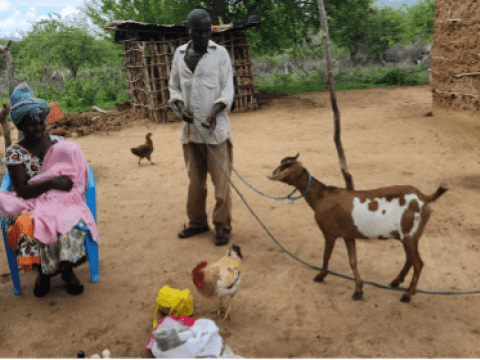Journeying from desperation to resilience

In November 2023, Mary Njeri, World Vision's Global Hunger Response Director, met Jennifer and her 9-month-old son, Benjamin, while visiting programme areas in eastern Kenya. Mary relays the ordeal that Benjamin went through just a month prior when he was diagnosed as severely malnourished.
Jennifer, a 40-year-old mother of six, has something to celebrate. Her youngest child, Benjamin, who was found to be severely malnourished in September 2023, is now a healthy 9-month-old after being admitted into our emergency hunger response project in Kitui, Kenya.
This project, funded by the United States government, targets people who are the most affected by the drought situation in Kenya, particularly children under 5 and pregnant and breastfeeding mothers as well as other vulnerable groups, such as the elderly, chronically ill, and persons with disabilities, providing them with immediate lifesaving assistance through community management of acute malnutrition, integrated mobile health and nutrition team outreach, infant and young child feeding and disease prevention counselling, in addition to capacity strengthening and community mobilisation to reduce communities’ vulnerability to acute malnutrition. Through this assistance, we are able to refer children, like Benjamin, who are suffering from acute malnutrition to the appropriate primary health-care support centres.
While working to ensure that children and other vulnerable people survive these life-threatening situations, we also understand that we must address the continuing worsening situations to help families and communities become more resilient to the issues driving hunger in their context. We do this by integrating our humanitarian emergency response with development programming such as improving water supply, promoting hygiene, distributing non-food items, and providing multi-month unconditional cash transfers to community members.
Benjamin’s rapid recovery is just one example of how impactful this integrated approach can be on individuals as well as households and communities. After just two months in the programme, he has gained over five kilogrammes and is in good health. Jennifer used the cash she received (KES 11,200, approximately US$71), in part, to buy nutritious food, which, coupled with her newly gained knowledge of how to prepare it in a healthy way, thanks to training with community health promoters, has improved Benjamin’s health. The cash also enabled Jennifer to buy two hens and a cock as well as a goat. These productive assets will ensure that she has a regular supply of eggs and goat milk to feed Benjamin and support her family financially.
Jennifer’s life has been totally transformed by her inclusion in this project. In addition to saving Benjamin’s life, her household has also been able to build its resilience and their long-term food security by diversifying the crops they grow. Previously they only planted millet and maize, a crop that often fails to mature due to low rainfall, but this year she was provided agricultural assets to be able to include the early maturing and highly nutritious green gram, cow pea, and sorghum crops.
Jennifer is just one person amongst the nearly 3,000 who have benefitted from this project. Many other families in her community have similar stories of how the project has improved their food security and children’s health and well-being.
Jennifer’s story is a good indication that scaling up integrated and intersectoral approaches across the humanitarian development and peace nexus is required to sustainably address the range of impacts and gaps posed by disasters. It is also critical to help the most impacted individuals and families move towards resilient recovery based on their values and priorities.